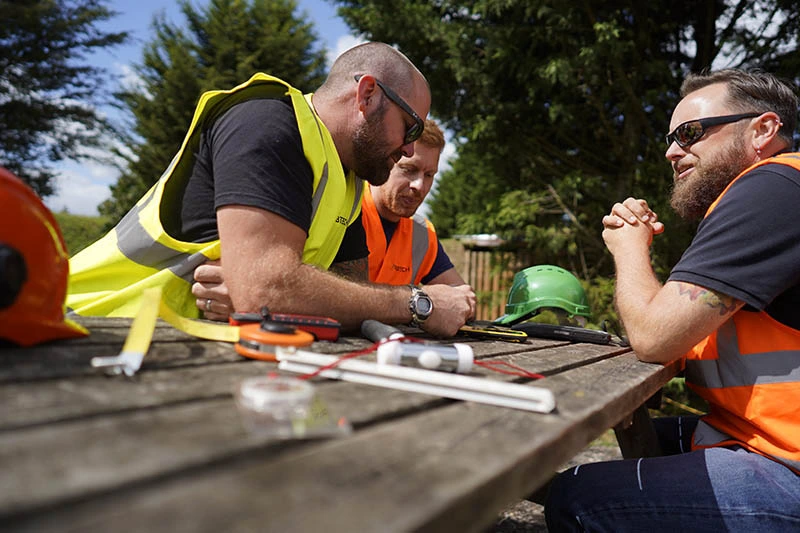Developing contaminated land: engage experts to satisfy planning conditions
Contaminated land refers to areas of soil, groundwater, or sediment that have been polluted by harmful substances due to industrial activities, natural sources, or other human interventions. These contaminants may be chemical, biological, or radioactive and can pose a risk of significant harm to human health and the environment if not managed effectively.
Working in accordance with the UK’s contaminated land regime and environmental damage regulations is essential for sustainable development, particularly as the government encourages the re use of brownfield sites under the National Planning Policy Framework (NPPF). Geo-environmental consultants are experts in advising on polluted land issues and creating a contaminated land strategy to make a site safe for re use.
Statutory definition of contaminated land
The Environmental Protection Act 1990 defines contaminated land as land where significant harm is being caused or where there is a significant possibility of such harm being caused to human health, protected species or controlled waters.
The legal definition is contained in Section 78A of the Act as land where substances in, on or under the land are causing or have the significant possibility of causing significant harm to human health or protected species or significant pollution of controlled waters.
The British Geological Survey provided guidance to the Department for Environment, Food & Rural Affairs between 2011-2012 on what normal levels of contaminant concentrations are in English soils. The information supports the Act’s revised part iia Contaminated Land Statutory Guidance.
Who is responsible for contaminated land?
Ensuring that development on contaminated land is safe is the legal duty of the developer, landowner or both. According to the Planning Portal: “Where a site is affected by contamination or land stability issues, responsibility for securing a safe development rests with the developer and/or landowner” (Paragraph 197, NPPF).
This highlights the importance of understanding, assessing, and remediating contamination risks before commencing any development project. Voluntary remediation at an early stage can prevent issues down the line with most sites.

The legal framework for contaminated land
In England and Wales, the management of contaminated land is governed by part iia of the Environmental Protection Act 1990. Under this legislation, local authorities are required to:
- Identify land which may be contaminated and inspect potentially contaminated land sites.
- Determine whether a site may pose a significant risk to human or environmental health.
- Ensure appropriate remediation measures are taken.
Land is classified into four categories based on risk levels:
- Category 1: High risk requiring immediate action.
- Category 2: Evidence of potential risk requiring remediation.
- Category 3: Low or uncertain risk; regulatory action may not be required.
- Category 4: No risk or acceptable levels of risk.
Land contamination can arise from previous land uses including:
- Industrial activities: Historical industrial operations such as factories, mines, and landfills often leave behind substances like heavy metals, radioactive substances, oils, and organic compounds.
- Natural sources: Underlying rock formations can sometimes release contaminants such as radon gas or heavy metals into the soil.
- Agricultural practices: Pesticides, fertilisers, and waste disposal can introduce pollutants into the land or cause pollution of controlled waters.
- Brownfield land: Previously developed sites may still harbour residual contaminants from prior use.
Why is land contamination a concern?
New development on a contaminated site can create significant risk to human health and future occupants by exposing the contamination. The development work may disturb radioactive contaminated land or create pollutant linkage – new pathways for the contamination – and introduce new receptors that can be adversely affected by contamination such as a person, protected species, surface water or controlled waters.
The risks posed by contaminated land depend on three key elements:
- Source: The presence of contaminants at harmful concentrations.
- Pathway: A means for the contaminants to reach humans or the environment, such as via ingestion, inhalation, or skin contact.
- Receptor: The individuals, ecosystems, or environments exposed to the contaminants.
If one of these elements is missing, the risk is significantly reduced. For example, heavily contaminated land that is inaccessible to the public poses minimal threat.
Assessing risk from contaminated land
A contaminated land find does not necessarily mean that it will pose an unacceptable risk. The significance of risk will vary according to the site’s history and the type of development proposed. To fully understand the risk, a land contamination assessment will be required.
While this will be a key factor in the development scheme, it is rare for a contaminated land report to completely prevent a development from proceeding. Information held on contaminated land sites may be available on a public register for the area in question.
Failing to follow statutory guidance to address any contamination issue correctly on the land affected could cause harm to human health and environmental health. For example, when managing protected species significant pollution with be a major factor in any local planning authority decision making process.

Contaminated land and the planning process
The NPPF emphasises sustainable development and encourages the remediation of contaminated land to make it free from the possibility of such harm that may result from contamination and safe to develop.
For any development site suspected of contamination, from radioactive substances to pollutant linkage, the local planning authority must be satisfied that the risks are understood and mitigated before granting planning permission.
Developers are required to provide sufficient information for such sites, often in the form of a land contamination assessment, to demonstrate that:
- The contamination issue has been thoroughly investigated.
- The proposed development will not pose unacceptable risks.
- Any necessary remediation is viable and practical.
The Land Contamination Risk Assessment
Assessing contamination risks involves several stages as determined by a series of guidelines, namely the Environment Agency Land Contamination Risk Management rules, part 2a of the Environmental Protection Act 1990 and building regulations.
- Desk study: A review of historical records, maps, and previous land uses to identify potential contamination sources.
- Site investigation: An inspection strategy detailing signs of potential contamination or land instability on or around the proposed development site.
- Soil and groundwater testing: Sampling and laboratory analysis to determine the presence and concentration of contaminants. Assistive technology may be used to help assess land affected by significant pollution.
- Risk analysis: Evaluating the likelihood and potential impact of contaminants on receptors.
If risks are identified, a remediation plan must be developed and submitted to the local planning authority. This plan outlines the measures required to make the land affected by contamination safe for its intended use and for future occupants.
The role of a geo-environmental consultant in contaminated land assessment
A competent geo-environmental consultant plays a crucial role in assessing and managing contaminated land. These specialists bring technical expertise to evaluate the geotechnical and environmental conditions of a site. Their responsibilities often include:
- Site investigations: Identifying the original source of contamination, pathways, and receptors via an inspection strategy.
- Risk assessments: Analysing data to determine the level of risk posed by contaminants.
- Remediation design: Devising a contaminated land strategy using practical solutions to address contamination, such as soil treatment, removal, or containment strategies, often using assistive technology.
- Compliance with regulations and legal implications: Ensuring all assessments and remediation efforts comply with statutory guidance and meet the legal requirements and planning conditions imposed by the enforcing authority.
- Monitoring and validation: Overseeing the remediation process and verifying that the development site meets safety criteria post-remediation and is suitable for use.
How to manage land contamination
By working closely with developers and the enforcing authority, geo-environmental consultants help ensure that contaminated land is safely redeveloped, reducing potential risks to health, the environment and future occupants of the site.
Engaging a competent person, as defined by the NPPF, to devise an inspection strategy detailing all the necessary information offers several benefits, including:
- Reducing the chance of objections to your planning application.
- Helping the local planning authority to process your application efficiently, minimising delays.
- Allowing the local planning authority to tailor conditions related to land contamination, reducing unnecessary requirements and the potential for requiring an environmental permit.
- Lowering the risk of delays from adverse environmental searches during property sales or a remediation notice being served.
- Ensuring the health of future occupants of the site is protected from contamination risks.
- Minimising potential future liabilities or legal implications related to land contamination.

Addressing land contamination through remediation
Remediation aims to reduce or eliminate risks associated with contaminated land. Common remediation techniques include:
- Excavation and removal: Contaminated soil is removed and replaced with clean soil.
- Soil treatment: Contaminants are neutralised or removed through physical, chemical, or biological methods.
- Capping: A barrier, such as a layer of clean soil or concrete, is placed over contaminated areas to prevent exposure and future land contamination.
- Groundwater treatment: Contaminated water is treated on-site or extracted for off-site treatment.
Why develop potentially contaminated land?
A presumption in favour of sustainable development lies at the heart of the National Planning Policy Framework, which states that planning policies and decisions should support the use of suitable brownfield land for housebuilding and other development. According to the NPPF, the purpose of the planning system is to achieve sustainable development which is viable and deliverable.
The redevelopment of brownfield sites aligns with the UK’s commitment to reducing urban sprawl and preserving special sites and greenfield land. The Environment Agency also places high importance on the safe redevelopment of potentially contaminated land to ensure that such pollution present is remediated correctly, to leave the land in such a condition that it is safe for re use. Information held on contaminated land sites may be available on a public register for the area in question.
Preventing future land contamination
With proper assessment and remediation, land affected by contamination can be transformed into safe, useable areas. While contaminated land can present challenges, it also offers opportunities for regeneration and sustainable development via a contaminated land strategy.
By understanding the sources, risks, and remediation options, developers, landowners, and local authorities can work together on a phased approach to remove the threat of pollution incidents and ensure safe and sustainable land use. The involvement of geo-environmental consultants adds a layer of expertise that helps navigate complex regulations, ensuring compliance with legal guidance in part iia of the Environmental Protection Act 1990, as well as conforming to guidelines from the Department for Environment, Food & Rural Affairs, the Environment Agency and Natural England.
With careful planning and collaboration, even the most challenging sites containing heavy metals can be made suitable for use again and successfully redeveloped, contributing to a cleaner and more sustainable future.
If you would like further guidance or a quote from a geo-environmental consultant, contact Arbtech’s expert team by filling in the quick quote form at the top of this page.





